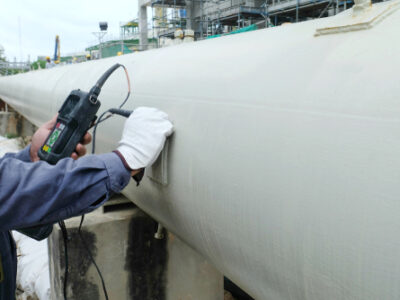 What Ultrasonic Testing Is Used For
What Ultrasonic Testing Is Used For
Ultrasonic testing or UT is a non-destructive testing (NDT) method that uses ultrasonic waves to detect and measure the thickness and internal flaws of materials. Ultrasonic waves are sound waves with frequencies higher than the human hearing range, typically above 20 kHz.
UT is widely used in various industrial applications to test the integrity of materials without causing damage to them. In this blog post, we will discuss what ultrasonic testing is used for in different industries.
1. Aerospace Industry
UT is commonly used in the aerospace industry to inspect aerospace components such as aircraft engines, landing gear, and wings. Ultrasonic testing can detect any internal flaws such as cracks, voids, and inclusions that may affect the structural integrity of the aircraft.
Moreover, UT is used to measure the thickness of the aircraft’s skin and evaluate any corrosion or delamination within the layers. This helps to ensure the safety and reliability of the aircraft during operation.
2. Oil and Gas Industry
UT is widely used in the oil and gas industry to inspect welding joints, pipelines, and storage tanks. Ultrasonic testing is a reliable method to detect any defects such as cracks, corrosion, and inclusions.
Moreover, UT is used to measure the thickness of the pipeline walls and evaluate any corrosion or erosion within the pipelines. This helps to ensure the safety and integrity of the oil and gas production and transportation systems.
3. Automotive Industry
UT is used in the automotive industry to inspect the internal components of vehicles such as engines, transmissions, and brakes. Ultrasonic testing can detect any internal flaws such as cracks, voids, and inclusions that may affect the performance and safety of the vehicle.
Moreover, UT is used to measure the thickness and uniformity of the vehicle’s metal components, including the body panels and frames. This helps to ensure the quality and durability of the vehicle during operation.
4. Manufacturing Industry
UT is used in the manufacturing industry to inspect the quality of raw materials, components, and finished products. Ultrasonic testing can detect any internal flaws such as cracks, voids, and inclusions that may affect the quality and reliability of the product.
Moreover, UT is used to measure the thickness and uniformity of the product’s metal components, including pipes, plates, and sheets. This helps to ensure the quality and consistency of the manufacturing process.
5. Construction Industry
UT is used in the construction industry to inspect concrete structures, including bridges, buildings, and dams. Ultrasonic testing can detect any internal flaws such as cracks and voids that may affect the structural integrity of the structure.
Moreover, UT is used to measure the thickness of the concrete and evaluate any delaminations or voids within the structure. This helps to ensure the safety and durability of the construction project.
6. Medical Industry
UT is used in the medical industry for diagnostic purposes, such as imaging organs and tissues in the body. Medical ultrasound imaging uses high-frequency sound waves to create images of internal organs, tissues, and blood vessels in the body.
Moreover, UT is used in therapeutic applications such as ultrasonic therapy, which uses concentrated ultrasonic waves to treat muscle and joint pain, as well as some conditions such as plantar fasciitis, tendinitis, and bursitis.
7. Nuclear Industry
UT is used in the nuclear industry to inspect the quality and safety of nuclear reactor components such as fuel rods, steam generators, and pressure vessels. Ultrasonic testing can detect any internal flaws such as cracks, voids, and inclusions that may affect the safety and reliability of the nuclear reactor.
Moreover, UT is used to measure the thickness and uniformity of the reactor’s metal components, including the piping and vessels. This helps to ensure the safety and reliability of the nuclear power plant.
Conclusion
Ultrasonic testing is a versatile and reliable NDT method used widely in various industries for testing the integrity and reliability of materials without causing damage to them. UT is used in the aerospace, oil and gas, automotive, manufacturing, construction, medical, and nuclear industries for different applications such as detecting internal flaws, measuring thickness and uniformity, and imaging internal structures.
Ultrasonic testing plays a crucial role in ensuring the safety, reliability, and quality of various products and processes, and its importance will continue to increase as industries strive for increased efficiency and safety.
